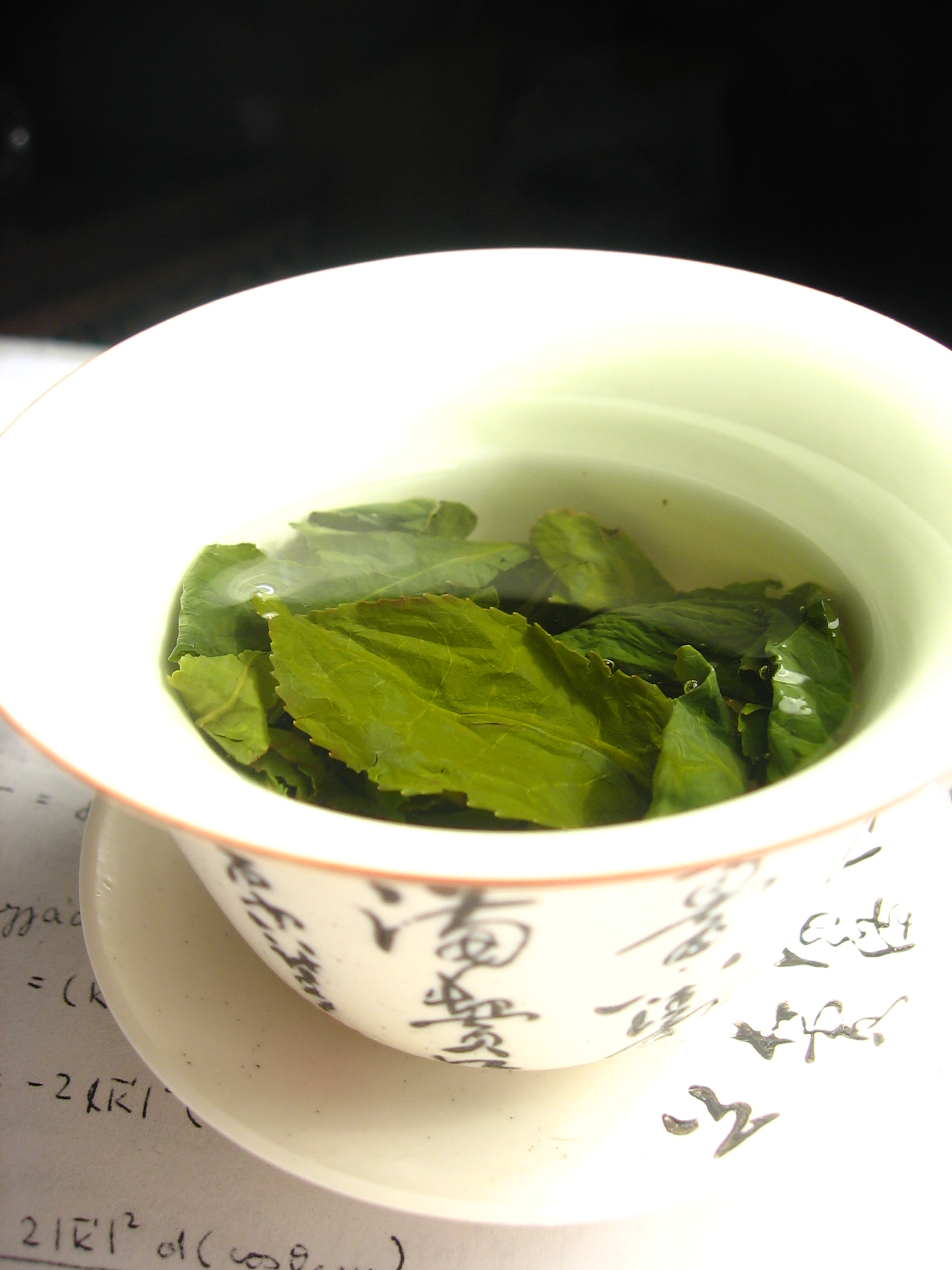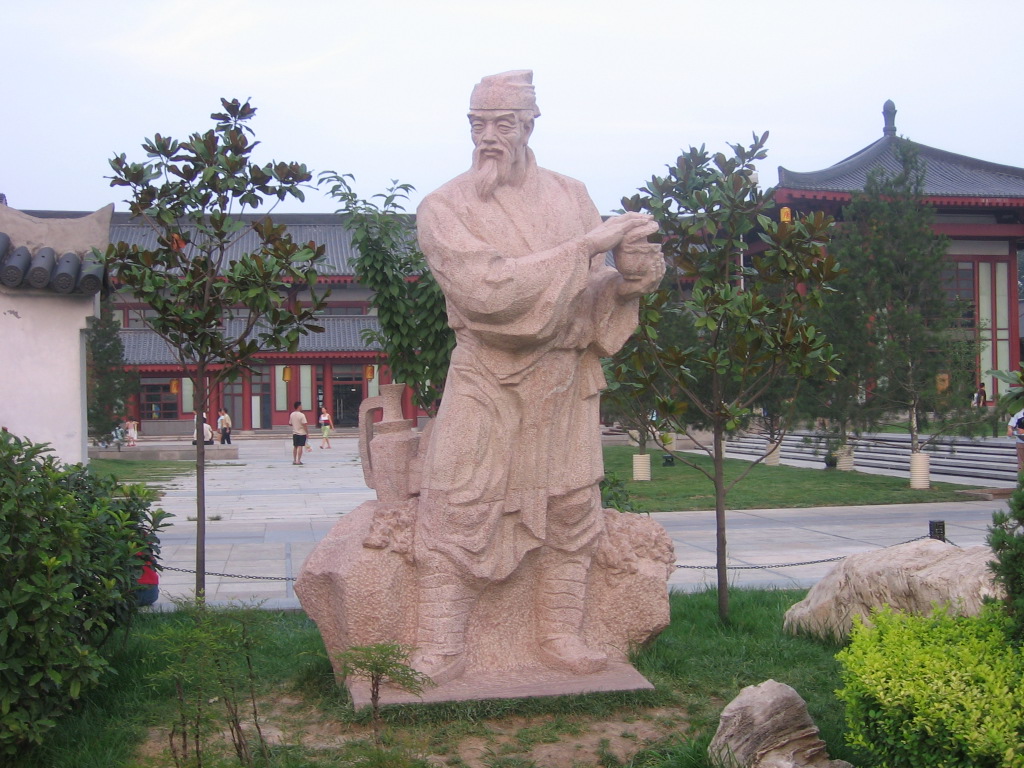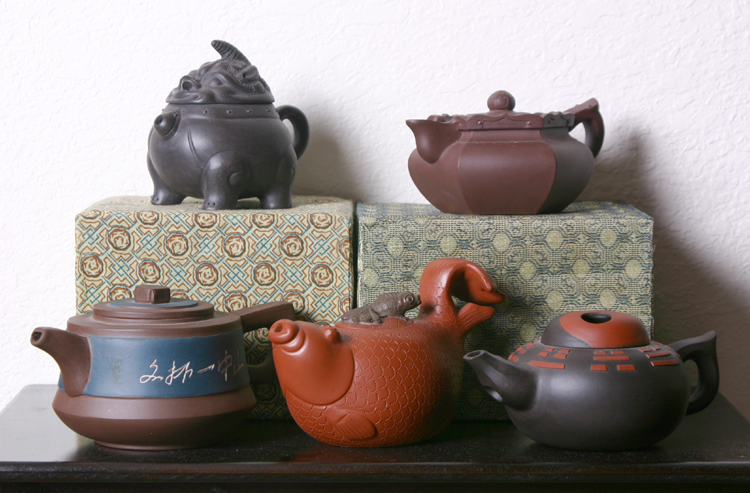|
Gaiwan
A (; ) or () is a Chinese lidded bowl without a handle, used for the infusion of tea leaves and the consumption of tea. It was invented during the Ming dynasty. It consists of a bowl, a lid, and a saucer. History Prior to the Ming dynasty (1368–1644), tea was normally consumed from the vessel in which it was prepared. As described by the tea master Lu Yu, this special bowl had to be large enough to accommodate the implements and actions of tea brewing, though compact enough to be held comfortably in the hands for consumption. The term for this versatile piece of equipment was (; lit. 'tea bowl'). It was during the Ming dynasty that the innovations in both tea ritual and tea preparation gave rise to the gaiwan. Design Gaiwans are made up of three parts: a saucer, a bowl, and a lid. They can be made from a variety of materials, including porcelain and glass. Gaiwans made from Yixing clay or jade are particularly prized by collectors of tea paraphernalia. They are typica ... [...More Info...] [...Related Items...] OR: [Wikipedia] [Google] [Baidu] |
Chinese Tea
Tea is a beverage made from the leaves of tea plants ('' Camellia sinensis'') and boiled water. Tea leaves are processed using traditional Chinese methods. Chinese tea is consumed throughout the day, including during meals, as a substitute for plain water, well-being or for simple pleasure. If medicine and tea are combined, people can also drink tea to cure diseases. History The practice of drinking tea has a long history in China, having originated there. Although tea originated in China, during the Tang Dynasty, Chinese tea generally represents tea leaves which have been processed using methods inherited from ancient China. According to legend, tea was discovered by Chinese Emperor Shen Nong in 2737 BC when a leaf from a nearby shrub fell into water the emperor was boiling. Tea is deeply woven into the history and culture of China. The beverage is considered one of the seven necessities of Chinese life, along with firewood, rice, oil, salt, soy sauce and vinegar. Chi ... [...More Info...] [...Related Items...] OR: [Wikipedia] [Google] [Baidu] |
Oolong
Oolong (, ; (''wūlóngchá'', "dark dragon" tea)) is a traditional semi-oxidized Chinese tea ('' Camellia sinensis)'' produced through a process including withering the plant under strong sun and oxidation before curling and twisting.Zhongguo Chajing pp. 222–234, 271–282, 419–412, chief editor: Chen Zhongmao, publisher: Shanghai Wenhua Chubanshe (Shanghai Cultural Publishers) 1991. Most oolong teas, especially those of fine quality, involve unique tea plant cultivars that are exclusively used for particular varieties. The degree of oxidation, which varies according to the chosen duration of time before firing, can range from 8 to 85%, depending on the variety and production style. Oolong is especially popular in south China and among ethnic Chinese in Southeast Asia as is the Fujian preparation process known as the Gongfu tea ceremony. Different styles of oolong tea can vary widely in flavor. They can be sweet and fruity with honey aromas, or woody and thick with roaste ... [...More Info...] [...Related Items...] OR: [Wikipedia] [Google] [Baidu] |
Steeping
Steeping is the soaking of an organic solid, such as leaves, in a liquid (usually water) to extract flavours or to soften it. The specific process of teas being prepared for drinking by leaving the leaves in heated water to release the flavour and nutrients is known as steeping. Herbal teas may be prepared by decoction, infusion, or maceration. Some solids are soaked to remove an ingredient, such as salt, where the solute is not the desired product. Corn One example is the steeping of corn (or maize), part of the milling process. As described by the US Corn Refiners Association, harvested kernels of corn are cleaned and then steeped in water at a temperature of for 30 to 40 hours. In the process their moisture content rises from 15% to 45% and their volume more than doubles. The gluten bonds in the corn are weakened and starch is released. The corn is then ground to break free the germ and other components, and the water used (steepwater), which has absorbed various nutrient ... [...More Info...] [...Related Items...] OR: [Wikipedia] [Google] [Baidu] |
Jingdezhen Porcelain
Jingdezhen porcelain () is Chinese ceramics, Chinese porcelain produced in or near Jingdezhen in Jiangxi province in southern China. Jingdezhen may have produced pottery as early as the sixth century CE, though it is named after the reign name of Emperor Zhenzong, in whose reign it became a major kiln site, around 1004. By the 14th century it had become the largest centre of production of Chinese porcelain, which it has remained, increasing its dominance in subsequent centuries. From the Ming dynasty, Ming period onwards, official kilns in Jingdezhen were controlled by the emperor, making imperial porcelain in large quantity for the court and the emperor to give as gifts. Although apparently an unpromising location for potteries, being a remote town in a hilly region, Jingdezhen is close to the best quality deposits of petuntse, or porcelain stone, in China, as well as being surrounded by forests, mostly of pine, providing wood for the kilns. It also has a river leading to rive ... [...More Info...] [...Related Items...] OR: [Wikipedia] [Google] [Baidu] |
Lu Yu
Lu Yu (; 733–804) or Lu Ji (陆疾), courtesy name Jici (季疵) was a Chinese tea master and writer. He is respected as the Sage of Tea for his contribution to Chinese tea culture. He is best known for his monumental book ''The Classic of Tea,'' also known as ''Ch'a Ching'' (simplified Chinese: 茶经), the first definitive work on cultivating, making and drinking tea. Biography Lu Yu was born in 733 in Tianmen, Hubei. For six years, Lu Yu stayed in Huomen mountain studying under the guidance of master Zou Fuzi. During this period, Lu Yu often brewed tea for his teacher. He also took care of fellow students' health using his remarkable knowledge in tea and herbs that he learned while at the Longgai Monastery. Whenever time permitted between his studies Lu Yu often went to the countryside to gather tea leaves and herbs. In one of those trips Lu Yu stumbled upon a spring underneath a 6-foot round rock and the water from the spring was extremely clear and clean. When Lu Yu ... [...More Info...] [...Related Items...] OR: [Wikipedia] [Google] [Baidu] |
Chawan
A ''chawan'' (; literally "tea bowl") is a bowl used for preparing and drinking tea. Many types of ''chawan'' are used in East Asian tea ceremonies. The choice of their use depends upon many considerations. History The ''chawan'' originated in China. The earliest ''chawan'' in Japan were imported from China between the 13th and the 16th centuries. The ''Jian chawan'', a Chinese tea bowl known as ''Tenmoku chawan'' in Japan, was the preferred tea bowl for the Japanese tea ceremony until the 16th century. In Japan, tea was also mainly drunk from this Chinese variety of tea bowls until about the 15th century. The Japanese term ''tenmoku'' is derived from the name of the Tianmu Mountain, where Japanese priests acquired these tea bowls from Chinese temples to bring back to Japan, according to tradition. An 11th-century resident of Fujian wrote about the Jian tea wares: : By the end of the Kamakura period (1185–1333), as the custom of tea drinking spread throughout Japan and th ... [...More Info...] [...Related Items...] OR: [Wikipedia] [Google] [Baidu] |
Porcelain
Porcelain () is a ceramic material made by heating substances, generally including materials such as kaolinite, in a kiln to temperatures between . The strength and translucence of porcelain, relative to other types of pottery, arises mainly from vitrification and formation of the mineral mullite within the body at these high temperatures. Though definitions vary, porcelain can be divided into three main categories: hard-paste, soft-paste, and bone china. The category that an object belongs to depends on the composition of the paste used to make the body of the porcelain object and the firing conditions. Porcelain slowly evolved in China and was finally achieved (depending on the definition used) at some point about 2,000 to 1,200 years ago; it slowly spread to other East Asian countries, then to Europe, and eventually to the rest of the world. Its manufacturing process is more demanding than that for earthenware and stoneware, the two other main types of pottery, and it ... [...More Info...] [...Related Items...] OR: [Wikipedia] [Google] [Baidu] |
Glass
Glass is a non-crystalline, often transparent, amorphous solid that has widespread practical, technological, and decorative use in, for example, window panes, tableware, and optics. Glass is most often formed by rapid cooling (quenching) of the molten form; some glasses such as volcanic glass are naturally occurring. The most familiar, and historically the oldest, types of manufactured glass are "silicate glasses" based on the chemical compound silica (silicon dioxide, or quartz), the primary constituent of sand. Soda–lime glass, containing around 70% silica, accounts for around 90% of manufactured glass. The term ''glass'', in popular usage, is often used to refer only to this type of material, although silica-free glasses often have desirable properties for applications in modern communications technology. Some objects, such as drinking glasses and eyeglasses, are so commonly made of silicate-based glass that they are simply called by the name of the material. Despite bei ... [...More Info...] [...Related Items...] OR: [Wikipedia] [Google] [Baidu] |
Yixing Clay
Yixing clay () is a type of clay from the region near the city of Yixing in Jiangsu Province, China, used in Chinese pottery since the Song dynasty (960–1279) when Yixing clay was first mined around China's Lake Tai. From the 17th century on, Yixing wares were commonly exported to Europe. The finished stoneware, which is used for teaware and other small items, is usually red or brown in colour. Also known as zisha () ware, they are typically left unglazed and use clays that are very cohesive and can form coils, slabs and most commonly slip casts. These clays can also be formed by throwing. The best known wares made from Yixing clay are Yixing clay teapots, tea pets, and other teaware. Clay types Zisha can be broadly categorised into three main colour: purple, red and beige: *''Purple: Zi sha'' or ''zi ni'' (紫砂 or 紫泥; literally, "purple sand/clay"): this stoneware has a purple-red-brown colour. *''Red: Zhu sha'' or ''zhu ni'' (朱砂 or 朱泥; literally, "cinnab ... [...More Info...] [...Related Items...] OR: [Wikipedia] [Google] [Baidu] |
Jade
Jade is a mineral used as jewellery or for ornaments. It is typically green, although may be yellow or white. Jade can refer to either of two different silicate minerals: nephrite (a silicate of calcium and magnesium in the amphibole group of minerals), or jadeite (a silicate of sodium and aluminium in the pyroxene group of minerals). Jade is well known for its ornamental use in East Asian, South Asian, and Southeast Asian art. It is commonly used in Latin America, such as Mexico and Guatemala. The use of jade in Mesoamerica for symbolic and ideological ritual was influenced by its rarity and value among pre-Columbian Mesoamerican cultures, such as the Olmecs, the Maya, and other ancient civilizations of the Valley of Mexico. Etymology The English word ''jade'' is derived (via French and Latin 'flanks, kidney area') from the Spanish term (first recorded in 1565) or 'loin stone', from its reputed efficacy in curing ailments of the loins and kidneys. ''Nephrite'' is der ... [...More Info...] [...Related Items...] OR: [Wikipedia] [Google] [Baidu] |
Infusion
Infusion is the process of extracting chemical compounds or flavors from plant material in a solvent such as water, oil or alcohol, by allowing the material to remain suspended in the solvent over time (a process often called steeping). An infusion is also the name for the resultant liquid. The process of infusion is distinct from both decoction—a method of extraction involving boiling the plant material—and percolation, in which water is passed through the material (as in a coffeemaker). History The first recorded use of essential oils was in the 10th or 11th century by the Persian polymath Avicenna, possibly in ''The Canon of Medicine''. Tea is far older than this, dating back to the 10th century BC as the earliest recorded reference. Preparation techniques Infusion is a chemical process that uses botanicals (typically dried herbs, flowers or berries) that are volatile and release their active ingredients readily in water, oil, or alcohol. In this process, a liquid i ... [...More Info...] [...Related Items...] OR: [Wikipedia] [Google] [Baidu] |
Craig Clunas
Alistair Craig Clunas (born 1 December 1954 in Aberdeen, Scotland) is Professor Emeritus of History of Art at the University of Oxford. As a historian of the art and history of China, Clunas has focused particularly on the Ming Dynasty (1368–1644). Life Clunas attended Aberdeen Grammar School from 1959 to 1972, which was followed by a Diploma with Distinction in spoken and written modern Chinese from the Peking Languages Institute in Beijing. He next majored in Chinese Studies at the University of Cambridge as an undergraduate, graduating with a BA (First Class Honours) in 1977 and afterwards went to the School of Oriental and African Studies (SOAS) at the University of London where he wrote his PhD dissertation on ''Injanasi's "Nigen Dabqur Asar": a Sino-Mongolian novel of the 19th century'' (completed 1983) under the supervision of Charles Bawden. Clunas began his scholarly career at the Victoria and Albert Museum, where for 15 years he was on the curatorial staff and was re ... [...More Info...] [...Related Items...] OR: [Wikipedia] [Google] [Baidu] |




.jpg)



